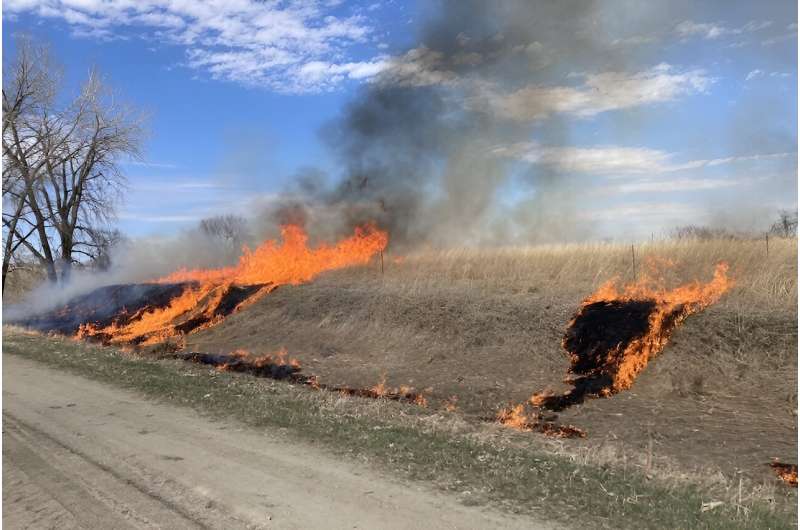This article has been reviewed according to Science X's editorial process and policies. Editors have highlighted the following attributes while ensuring the content's credibility:
fact-checked
peer-reviewed publication
trusted source
proofread
Using fire to revive a fragmented prairie landscape

Although fire can kill some plants, many plants need fires to survive and flower. Entire habitats like tallgrass prairie depend on fires, which historically burned across thousands of acres of grasslands in North America each year.
Today, fires are an important tool for managing prairies and conserving native plant diversity. On large preserves, we know that fire reduces shade, influences soil, and improves seed production. But what about the small fragments of prairie scattered across the Midwest?
New research published in the Proceedings of the National Academy of Sciences looks at how fires affect pollination in isolated remnants of prairie, which are critically important for plants and pollinators.
Scientists from the University of Minnesota and the Negaunee Institute for Plant Conservation Science and Action at the Chicago Botanic Garden investigated how fires stimulate flowering and pollination and how much the influence of fire depends on the population size.
During a six-year study of Echinacea angustifolia, a prairie plant commonly known as the narrow-leaved purple coneflower, researchers tracked 6,357 individuals across 35 populations in western Minnesota ranging in size from three to nearly 4,000 adult plants. Before and after 22 experimental burns, researchers measured flowering effort and outcomes to learn how fire influences different stages of plant reproduction in large and small populations.
The researchers found that:
- The beneficial effects of fire on plant reproduction in North American prairies depend on the size of the plant population.
- Summer flowering increases after spring fires regardless of the size of the prairie. In contrast, pollination and seed yield increased the most in small populations (30–100 individuals).
- Larger populations got a substantial boost in seed production after fires, but the smallest population gained no benefits.
"Seed production depends on both reproductive effort as well as pollination," said Amy Waananen, postdoctoral research scientist at the U of M and co-author of the study. "Bees are most likely to move pollen between plants that are nearby and flowering at the same time. In small populations, even after fire when more individuals are likely to flower, potential mates may still be few and far between."
The narrow-leaved purple coneflower is native to the tallgrass prairie between the Mississippi River and the Rocky Mountains, ranging from Texas to Canada. Researchers use this plant as a model organism to study perennial plants in grasslands. Related species (such as Echinacea purpurea and ornamental cultivars) are often grown in gardens and are used in traditional medicine.
"Land managers decide which prairies to burn and how frequently to burn them. Our findings help guide those decisions. In particular, we learned that prescribed burns really help smaller populations," said Waananen. "It is important to act soon to preserve species. If a population becomes too small, fire probably will not be able to bring it back."
More information: Jared Beck et al, Habitat fragmentation decouples fire-stimulated flowering from plant reproductive fitness, Proceedings of the National Academy of Sciences (2023). DOI: 10.1073/pnas.2306967120
Journal information: Proceedings of the National Academy of Sciences
Provided by University of Minnesota




















